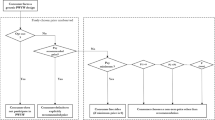Abstract
This research examines how consumers respond to different shipping fee structures. Focusing on two of the most common shipping fee structures, flat rate shipping and threshold-based free shipping, we first demonstrate that offer evaluations are less (more) favorable with threshold-based free shipping when order value is below (above) the free shipping threshold compared to flat rate shipping. However, when an alternative more important referent is present, the effect of shipping fee structure is attenuated. Second, we show that although perceptions of shipping fees as a profit generator are higher (lower) under threshold-based free shipping relative to flat rate shipping for order values below (above) the free shipping threshold, providing a justification for the shipping fee by explicitly linking it to delivery costs encourages consumers to view the shipping fee as a cost of doing business rather than as a profit generator, thus raising offer evaluations.
Similar content being viewed by others
References
Baron, R. M., & Kenny, D. A. (1986). The moderator-mediator variable distinction in social psychological research: conceptual, strategic, and statistical considerations. Journal of Personality and Social Psychology, 51, 1173–82.
Barsh, J., Blair, C., & Grosso, C. (2000). How E-tailing can rise from the ashes. The Mckinsey Quarterly, 3, 98–109.
Bies, R. J., & Shapiro, D. L. (1988). Voice and justification: their influence on procedural fairness and judgments. Academy of Management Journal, 31, 676–685.
Campbell, M. C. (1999). Perceptions of price unfairness: antecedents and consequences. Journal of Marketing Research, 36, 187–199.
Chakravarti, D., Krish, R., Paul, P., & Srivastava, J. (2002). Partitioned presentation of multicomponent bundle prices: evaluation, choice, and underlying processing effects. Journal of Consumer Psychology, 12(3), 215–29.
Cheema, A. (2008). Surcharges and seller reputation. Journal of Consumer Research, 35(2), 167–77.
ComCult Research. (2003). ComCult Study eCommerce. http://www.comcult.com.
Darke, P. R., & Dahl, D. W. (2003). Fairness and discounts: the subjective value of a bargain. Journal of Consumer Psychology, 13(3), 328–38.
Fiske, S. T., & Taylor, S. E. (1991). Social cognition. New York: McGraw-Hill.
Folkes, V. S. (1984). Consumer reactions to product failure: An attributional approach. Journal of Consumer Research, 10 (March), 398–409.
Hamilton, R. W., & Srivastava, J. (2008). When 2 + 2 is not the same as 1 + 3:variations in price sensitivity across components of partitioned prices. Journal of Marketing Research, 45(4), 450–61.
Hamilton, R. W., Srivastava, J., & Abraham, A. T. (2010). When should you nickel and dime your customers? A manager’s guide to benefits-based price partitioning. MIT Sloan Management Review, 52(1), 59–67.
Haws, K. L., & Bearden, W. O. (2006). Dynamic pricing and consumer fairness perceptions. Journal of Consumer Research, 33(December), 304–311.
Hsee, C. K., & Leclerc, F. (1998). Will products look more attractive when presented separately or together? Journal of Consumer Research, 25(September), 175–86.
Hsee, C. K., Loewenstein, G. F., Blount, S., & Bazerman, M. H. (1999). Preference reversals between joint and separate evaluations of options: a review and theoretical analysis. Psychological Bulletin, 125(5), 576–90.
Kahneman, D., & Miller, D. T. (1986). Norm theory: comparing reality to its alternatives. Psychological Review, 93(2), 136–53.
Kahneman, D., & Tversky, A. (1979). Prospect theory: an analysis of decision under risk. Econometrica, 47(March), 163–91.
Kahneman, D., Knetsch, J. L., & Thaler, R. (1986). Fairness as a constraint on profit seeking: entitlements in the market. The American Economic Review, 76(4), 728–741.
Kelley, H. H. (1967). Attributional theory in social psychology. In D. Levine (Ed.) Nebraska symposium of motivation (pp. 192-238). Lincoln: University of Nebraska Press.
Lassar, W. M., Folks, V. S., Grewal, D., & Costley, C. (1997). Consumer affective reactions to product problems when the timing of warranty expiration varies. Journal of Business Research, 42, 265–70.
Lewis, M. (2006). The effect of shipping fees on customer acquisition, customer retention, and purchase quantities. Journal of Retailing, 82, 13–23.
Lewis, M., Singh, V., & Fay, S. (2006). An empirical study of the impact of nonlinear shipping and handling fees on purchase incidence and expenditure decisions. Marketing Science, 25, 51–64.
Morwitz, V. G., Greenleaf, E. A., & Johnson, E. J. (1998). Divide and prosper: consumers’ reactions to partitioned prices. Journal of Marketing Research, 35(November), 453–63.
Rosen, K. T., & Howard, A. L. (2000). E-retail: gold rush or fool’s gold. California Management Review, 42(3), 72–100.
Schindler, R. M., Morrin, M., & Bechwati, N. N. (2005). Shipping charges and shipping charge skepticism: Implications for direct marketers’ pricing formats. Journal of Interactive Marketing, 9, 41–53.
Smith, M. D., & Brynjolfsson, E. (2001). Consumer decision making at an internet shopbot: brand still matters. The Journal of Industrial Economics, 49(4), 541–58.
Tsiros, M., Mittal, V., & Ross, W. T. (2004). The role of attributions in customer satisfaction. Journal of Consumer Research, 31, 476–483.
Weiner, B. (2000). Attributional thoughts about consumer behavior. Journal of Consumer Research, 27(December), 382–387.
Xia, L., & Monroe, K. B. (2004). Price partitioning on the internet. Journal of Interactive Marketing, 18(4), 63–73.
Author information
Authors and Affiliations
Corresponding author
Additional information
Listed alphabetically, the three authors contributed equally to the article. This research was partially funded by the Alison and Norman Axelrod’74 endowed summer research fellowship awarded to the first author by Lehigh University and by the summer research grant awarded to the second author by the Robert H. Smith School’s Center for Excellence in Service and the Research Committee.
Rights and permissions
About this article
Cite this article
Koukova, N.T., Srivastava, J. & Steul-Fischer, M. The effect of shipping fee structure on consumers’ online evaluations and choice. J. of the Acad. Mark. Sci. 40, 759–770 (2012). https://doi.org/10.1007/s11747-011-0281-2
Received:
Accepted:
Published:
Issue Date:
DOI: https://doi.org/10.1007/s11747-011-0281-2




